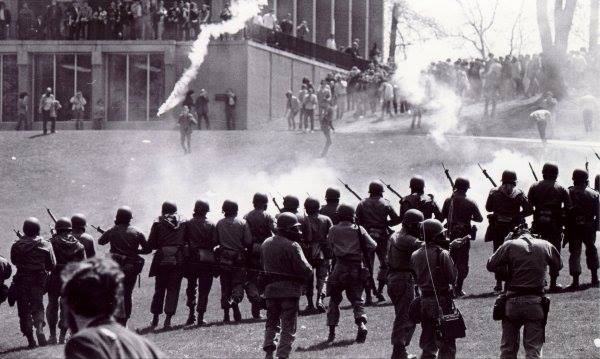
05 May THE KENT STATE MASSACRE, Part 2
THE KENT STATE MASSACRE – 45 YEARS LATER
PART II
MAY 4, 1970
As the sun rose over the campus on Monday, May 4th, the National Guard remained on there in force. Initially a rally had been planned for noon that day, but Governor Rhodes had effectively banned the rally that was to be held with his statements of the previous day. Although he had never actually declared martial law, his promises to do so seemed to inflame the situation and the protest began to turn from a protest against the war to a protest against the presence of the National Guard. Confrontation was in the air and as the morning drew on the crowds began to gather.
Shortly before noon, General Canterbury, of the Ohio National Guard, made the decision to order the demonstrators to disperse. A Kent State police officer standing by the Guard made an announcement using a bullhorn. When this had no effect, the officer was placed in a jeep along with several Guardsmen and driven across the Commons to tell the protestors that the rally was banned and that they must disperse. This was met with angry shouting and rocks, and the jeep retreated. Canterbury then ordered his men to load and lock their weapons, tear gas canisters were fired into the crowd around the Victory Bell, and the Guard began to march across the Commons to disperse the rally. The protestors moved up a steep hill, known as Blanket Hill, and then down the other side of the hill onto the Prentice Hall parking lot as well as an adjoining practice football field. Most of the Guardsmen followed the students directly and soon found themselves somewhat trapped on the practice football field because it was surrounded by a fence. Yelling and rock throwing reached a peak as the Guard remained on the field for about ten minutes. Several Guardsmen could be seen huddling together, and some Guardsmen knelt and pointed their guns, but no weapons were shot at this time. The Guard then began retracing their steps from the practice football field back up Blanket Hill. As they arrived at the top of the hill, twenty-eight of the more than seventy Guardsmen turned suddenly and fired their rifles and pistols. Many guardsmen fired into the air or the ground. However, a small portion fired directly into the crowd. Altogether between 61 and 67 shots were fired in a 13 second period.
Four Kent State students died as a result of the firing by the Guard. The closest student was Jeffrey Miller, who was shot in the mouth while standing in an access road leading into the Prentice Hall parking lot, a distance of approximately 270 feet from the Guard. Allison Krause was in the Prentice Hall parking lot; she was 330 feet from the Guardsmen and was shot in the left side of her body. William Schroeder was 390 feet from the Guard in the Prentice Hall parking lot when he was shot in the left side of his back. Sandra Scheuer was also about 390 feet from the Guard in the Prentice Hall parking lot when a bullet pierced the left front side of her neck.
Nine Kent State students were wounded in the 13 second fusillade. Most of the students were in the Prentice Hall parking lot, but a few were on the Blanket Hill area. Joseph Lewis was the student closest to the Guard at a distance of about sixty feet; he was standing still with his middle finger extended when bullets struck him in the right abdomen and left lower leg. Thomas Grace was also approximately 60 feet from the Guardsmen and was wounded in the left ankle. John Cleary was over 100 feet from the Guardsmen when he was hit in the upper left chest. Alan Canfora was 225 feet from the Guard and was struck in the right wrist. Dean Kahler was the most seriously wounded of the nine students. He was struck in the small of his back from approximately 300 feet and was permanently paralyzed from the waist down. Douglas Wrentmore was wounded in the right knee from a distance of 330 feet. James Russell was struck in the right thigh and right forehead at a distance of 375 feet. Robert Stamps was almost 500 feet from the line of fire when he was wounded in the right buttock. Donald Mackenzie was the student the farthest from the Guardsmen at a distance of almost 750 feet when he was hit in the neck.
Schroeder and Kahler were hit while lying prone. MacKenzie and Canfora were wounded while running away from the line of fire. Russell and Stamps were apparently hit by ricochets. Two of the casualties, Lewis and Russell, were wounded twice. Of the 25 riflemen who admitted firing, 21 said they fired their 41 shots either into the air or into the ground. Four riflemen acknowledged firing nine of their total of 14 shots into the crowd. Two men fired pistols: one said he fired two shots into the crowd and the other said he fired three shots into the air. The guardsman who fired a shotgun said he fired a single blast into the air. Russell was wounded by shotgun pellets believed to have ricocheted off nearby trees. The guardsmen admit firing a total of only 11 rounds into the crowd. Besides the 15 wounds sustained by the casualties, however, a number of parked cars in the Prentice Hall parking lot afterward showed bullet holes.
The scene after the shooting was tense, and there was a possibility of further trouble. After an ambulance removed Miller’s body, a demonstrator who had carried a black flag during the confrontation dipped the flag into the pool of Miller’s blood and waved it at nearby students in an apparent effort to inflame them further. Canterbury withdrew his troops to the Commons almost immediately. He ordered a weapons check to determine how many guardsmen fired how many rounds. He also ordered that no more rounds be fired except at a specified target and upon an officer’s order.
After the casualties were removed, students began to gather again on the hills overlooking the Commons. The largest concentration, varying from 200 to 300, congregated on the slope below Johnson Hall at one corner of the Commons. Many of them would later have trouble describing their emotions.
Professor Glenn W. Frank obtained permission from General Canterbury to allow faculty marshals to attempt to persuade this crowd to leave without further military action. Frank and Dr. Seymour H. Baron, who had a bullhorn, persuaded the students to sit down instead of milling around. Baron warned the students they might be shot if they approached the guardsmen again. “They’re scared to death,” he said of the guardsmen, “a bunch of summertime soldiers. They’re not professionals. They’re scared kids.”
Major Jones of the National Guard approached. Aware of the crowd’s volatile mood, Frank told him, “For God’s sake, don’t come any closer.” Jones said, “My orders are to move ahead.” Frank replied, “Over my dead body.”
Jones withdrew, but soon a detachment of guardsmen appeared along the hill behind the students. Frank pleaded with the students to leave. “I am begging you right now,” he said, “if you don’t disperse right now, they’re going to move in, and there can only be a slaughter. Jesus Christ, I don’t want to be a part of this.” When the guardsmen appeared behind the students, some of the students felt surrounded. Some panicked and ran. Others adamantly refused to leave and had to be physically carried away by faculty marshals and graduate students. The entreaties of Baron and Frank induced others to walk away.
The University was ordered closed immediately, first by President Robert White and then indefinitely by Portage County Prosecutor Ronald Kane under an injunction from Common Pleas Judge Albert Caris. Classes did not resume until the Summer of 1970, and faculty members engaged in a wide variety of activities through the mail and off-campus meetings that enabled Kent State students to finish the semester.
The actions of the Guard and the students that day would examined by the courts and Justice Department, and many questions still remain unanswered to this day. According to the guardsmen they fired because they felt they were in fear of their lives, and did so in self-defense. It has been established that the students were not armed with firearms, but were throwing rocks and other objects. The students would claim they had a constitutionally protected right to be where they were and were essentially attacked by the guardsmen. in the years to come both sides would be questioned and both the guardsmen and the students were in the wrong to some degree that day.
In Part III – the Aftermath.



No Comments